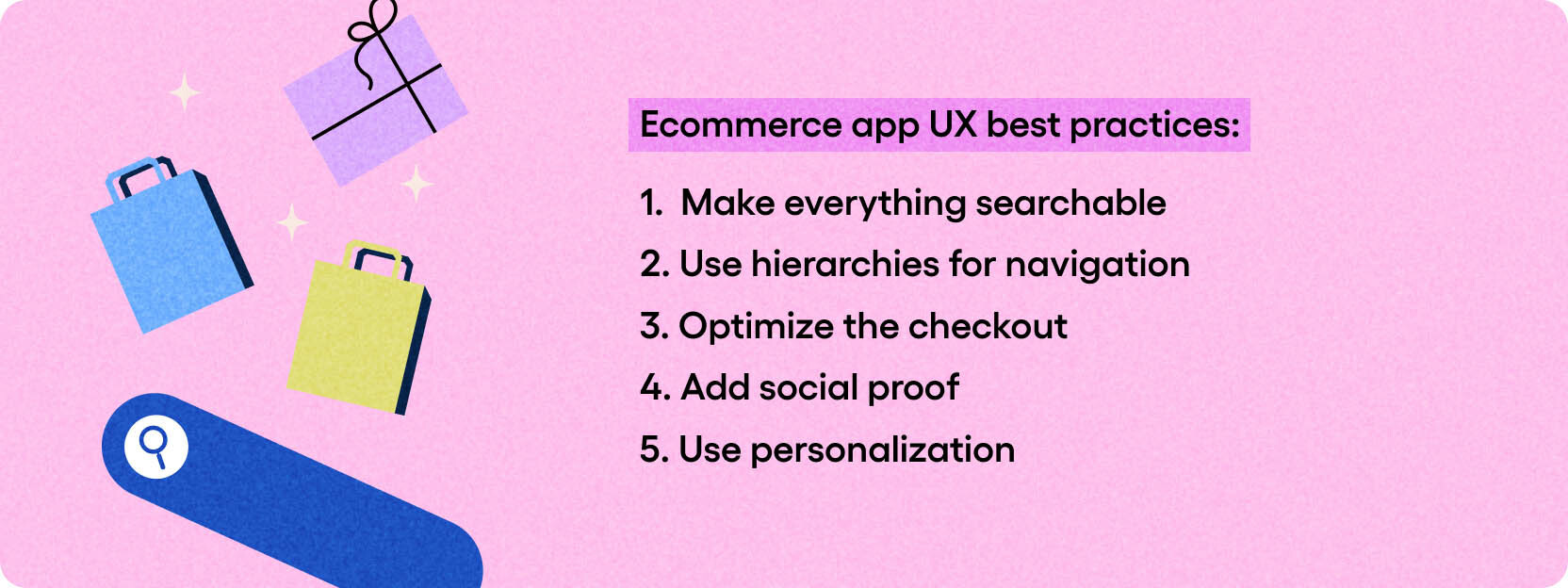UX best practices for people who love their apps

The best UX sets a precedent. It can be culture-defining, inspiring years of updates to come. Just as significantly, it can transform the fortunes of almost any product.
Getting the fundamentals perfect is essential for any UX professional or product manager hoping to produce that culture-defining design. That starts with understanding and embracing UX best practices.
UX plays a role throughout the customer journey
From the moment the user clicks on the homepage to the final order confirmation, user experience is vitally important.
Initially, it can influence how customers find and evaluate your product. Later on, UX will decide whether customers stay engaged and how willing they are to part with their money.

If you can provide a smooth journey through each stage, users will likely repay the favor. According to Forrester's research, sites with excellent user experience see a conversion rate that is 400% higher than similar sites with inferior design.
Of course, delivering this kind of user experience does pose a challenge. It’s a hurdle that causes many companies to trip.
To avoid a similar fate, every business with a digital product should pay attention to the best UX practices. When followed closely, these principles of design and usability provide a framework for delivering the kind of user experience that customers crave.
Nine UX principles to live by
The field of UX design is constantly evolving. New concepts emerge, and old ones fall out of fashion within months. But as time passes, a few ideas stick around — because they work. Applying these design principles to your work is certain to have a positive effect on the outcome:
1. Establish a UX design process
User experience design is a complex dance with many moving parts. This is why the best UX examples come from businesses with an established process.
There are several benefits of creating a clear workflow:
Clear pathways of communication within your team
Each person involved in the process knows their role
Quality assurance can be baked into the process
Smoother hand-offs, leading to improved efficiency
It would be fair to say that building a UX design process is the most important principle on this list, but it creates a framework to guide your work.
2. Maintain consistency
Imagine reading a book where the direction of the text changes every page. It would certainly be confusing and probably hinder your ability to focus on the content.
This mental image shows why consistency is important for UX design. If you want your product to be easy to use, maintaining some level of regularity is advisable. Examples include:
Using each icon for only one purpose
Keeping the number of fonts to a minimum
Choosing a color palette and sticking with it throughout your product
Making gesture controls universal
This consistency ensures that users only have to learn how to use your product once. It should prevent unnecessary confusion and frustration, too.
3. Simplicity is better than clever
People who design things tend to have a playful streak. While the average person is delighted with a house with four walls and a sloping roof, architects love using vast amounts of glass, cantilevered overhangs, and rounded borders. It’s smart but impractical.
In designing digital products, many UX professionals fall into the same trap, crafting user experiences that are beautiful but confusing. Such designs do well on Dribbble but won’t give your customers the desired user experience.
There is a simple cure: stick with simplicity. It might seem tedious, but the truth is that no one downloads a mobile app to admire a unique menu toggle. If there is an obvious way to do something, think twice before switching it up.
4. Accessibility should be a priority
From a business perspective, design decisions that can significantly increase the total reachable market of your product are worth pursuing. Accessibility fits that description.
By making a product or service accessible, your business can reach and retain millions of underserved potential customers with disabilities and impairments. Moreover, several jurisdictions globally actually have legal requirements for digital accessibility.
Some examples of accessibility in product design include:
Making a website navigable by keyboard for users who cannot use a mouse or trackpad
Adding subtitles to videos to help users with hearing impairments and those watching in a noisy environment
Creating alt-text for images for visually impaired users who rely on screen readers
Aside from the specific benefits of reaching more users, prioritizing accessibility promotes the general principle of adapting your product to the user’s needs — which is the foundation for great UX.
5. Always conduct user testing
You might think you know what users want. Perhaps you have even asked them what they wish to do and applied your findings to the design process. But do your users enjoy using your product?
The truth is, it’s impossible to know without conducting user testing.
Running live tests with users can provide invaluable insights about your product — from revealing the most popular screens to highlighting potential sticking points in the customer journey. Usability testing can also pinpoint any technical flaws that may detract from all your good work on the design side.
The 5th principle of UX design is non-negotiable. If you fail to conduct user research, you’re flying blind.
6. Design for errors
In an ideal world, users would navigate your product in the way you intended. But no matter how carefully you design your interface and onboarding tour, problems will arise. With this in mind, planning for errors is considered a best practice in UX.
Designing for errors means accepting that users will find flaws. It also requires you to consider those flaws and shape your product to mitigate the problems.
A simple example of this would be a drop in connection. Creating a clear error message will keep your users informed and help them to solve the problem themselves.
7. Pay attention to micro interactions
While it’s important to consider the big picture, UX also relies on the details.
Microinteractions are subtle design elements that accomplish a specific task and aim to enrich the overall user experience. They often go unnoticed when done right but are crucial in creating a smoother, more intuitive interaction with the user interface.
Examples include:
A button changes color when hovered over
A checkmark appears when a task is completed
The “refresh” animation when you pull down from the top of the screen on a mobile device
The “like” function on social media platforms changes color when tapped
Introducing micro interactions into your product can enhance the user experience by providing immediate feedback. This can help guide users through each process and even add fun or delight to your product.
8. Consider culture
Microinteractions are not the only minor details that affect user experience. If you plan to launch your product worldwide, it’s critical to consider each region's cultural norms.
Culture plays a significant role in how users are likely to perceive and interact with your product. Make the wrong choices, leaving the door open to confusion, misinterpretation, or offense. Each will significantly degrade the user experience.
As a real-world example, consider color symbolism. In Western cultures, white is associated with purity and innocence. But in some Asian cultures, it's linked with mourning and death. In this context, promoting wedding services with a primarily white website will likely appear inappropriate and offputting.
For this reason, it’s always worth conducting cultural research when designing international products.
9. Embrace iterative design
“Getting it right the first time” is a useful motto in many fields of work, but it doesn’t apply in UX and UI design. Iteration is essential for perfecting the user experience, even for apps and websites that start with good UX design.
The iterative design begins at the concept stage once wireframes have been converted into prototypes. This is the first opportunity to gather the opinions of users. Your UX research should point towards any changes needed in the initial design before the project moves to the next stage.
Businesses that adopt the iterative approach tend to deliver a better user experience overall because their products and services have been fine-tuned. This constant optimization tends to iron out any kinks before exposing the product to real users.

The only UIKit you need to build in-app chat.
Mobile app UX best practices
The UX design best practices mentioned above are considered universal. However, every niche of development and interaction design has its own principles that apply in addition.
Ecommerce app UX best practices

Let’s consider e-commerce. Designing a website or app that allows customers to browse and discover thousands of products enjoyably is no easy feat. As such, experienced UX professionals in this field tend to follow these principles:
Make everything searchable — If a customer knows what they want, they can get to the relevant products quickly.
Use hierarchies for navigation — For customers who want to browse, drop-down menus with a visual hierarchy can make it easier to navigate.
Optimize the checkout — No one enjoys filling out forms, so make it as frictionless as possible.
Add social proof — Adding customer reviews to product pages is a powerful way to drive sales.
Use personalization — Providing a personalized experience can help customers to find the products that are most relevant to them.
Another critical factor in ecommerce UX is after-sales support. Intelligent chatbots and asynchronous chat can massively improve customer experience for businesses with limited resources in this area.
Fintech app UX best practices
Another category of mobile apps with precise UX requirements is fintech. With significant capital at stake, users want to feel confident in any product they use.
The following principles apply here:
Give users control — The best way to breed confidence in your product is by handing over control through preferences and settings.
Emphasize security — Maintaining tight security is important in any fintech app; consider highlighting security features within your front end to make users feel secure.
Provide a thorough onboarding experience — Mistakes can be costly when using a fintech app, and users may blame your business for such errors if they can’t work out how to use your product.
Make it familiar — Allowing users to send and manage money through a chat-like interface is much more user-friendly.
Transparency is vital — Being clear about terms and conditions is an excellent way to foster trust.
More in Sendbird’s UIKit
Applying every one of these principles right off the bat is a challenge for any business. We created a starter template to work from to give you a head start.
Sendbird’s UIKit includes everything you need to integrate social features into your iOS app. It follows messaging and chatbot UX best practices and is designed to fit seamlessly with any existing branding.
The UIKit is backed up by our cutting-edge messaging platform. Sendbird Chat allows you to integrate communication features into your existing app or build an entirely new messaging app from scratch.












